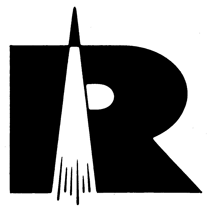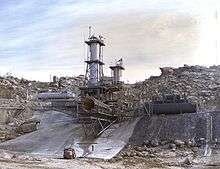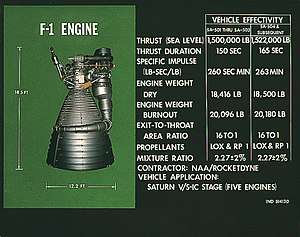Rocketdyne
 | |
| Industry | Rocket engines |
|---|---|
| Fate | Acquired |
| Successor |
Pratt & Whitney Rocketdyne (2005-2013) Aerojet Rocketdyne (2013-) |
| Founded | 1955 |
| Defunct | 2005 |
| Headquarters | Canoga Park, California, United States |
Key people |
John Leland "Lee" Atwood James H."Dutch" Kindelberger Samuel Kurtz "Sam" Hoffman |
| Parent |
North American Aviation Rockwell International Boeing |
Rocketdyne was an American rocket engine design and production company headquartered in Canoga Park, in the western San Fernando Valley of suburban Los Angeles, in southern California.
The Rocketdyne Division was founded by North American Aviation (NAA) in 1955, and was later part of Rockwell International (1967-1996) and Boeing (1996-2005). In 2005, the Rocketdyne Division was sold to United Technologies Corporation, becoming Pratt & Whitney Rocketdyne as part of Pratt & Whitney. In 2013, Pratt & Whitney Rocketdyne was sold to GenCorp, which merged it with Aerojet to form Aerojet Rocketdyne.[1]
History
After World War II, North American Aviation (NAA) was contracted by the Defense Department to study the German V-2 missile and adapt its engine to SAE measurements and U.S. construction details. NAA also used the same general concept of separate burner/injectors from the V-2 engine design to build a much larger engine for the Navaho missile project (1946-1958). This work was considered unimportant in the 1940s and funded at a very low level, but the start of the Korean War in 1950 changed priorities. NAA had begun to use the Santa Susana Field Laboratory (SSFL) high in the Simi Hills around 1947 for the Navaho's rocket engine testing, At that time the site was much further away from major populated areas than the early test sites NAA had been using within Los Angeles.
Navaho ran into continual difficulties and was canceled in 1958 when the Chrysler Corporation Missile Division's Redstone missile design (essentially an improved V-2 [2]) had caught up in development. However the Rocketdyne engine, known as the A-5 or NAA75-110, proved to be considerably more reliable than the one developed for Redstone, so the missile was redesigned with the A-5 even though the resulting missile had much shorter range.
As the missile entered production, NAA spun off Rocketdyne in 1955 as a separate division, and built its new plant in the then small Los Angeles suburb of Canoga Park, in the San Fernando Valley near and below its Santa Susana Field Laboratory.
In 1967, NAA, with its Rocketdyne and Atomics International divisions, merged with the Rockwell Corporation to form North American Rockwell, becoming in 1973 Rockwell International.
Thor, Delta, Atlas
Rocketdyne's next major development was its first all-new design, the S-3D, which had been developed in parallel to the V-2 derived A series. The S-3 was used on the Jupiter missile design, essentially a development of the Redstone, and was later selected for the considerably more capable Air Force Thor missile and its Army counterpart, the Jupiter. An even larger design, the LR89/LR105, was used on the Atlas missile. The Thor had a short military career, but it was used as a satellite launcher through the 1950s and 60s in a number of different versions. One, Thor Delta, became the baseline for the current Delta series of space launchers, although since the late 1960s the Delta has had almost nothing in common with the Thor. Although the original S-3 engine was used on some Delta versions, most use its updated RS-27 design, originally developed as a single engine to replace the three-engine cluster on the Atlas.
The Atlas also had a short military career as a deterrent weapon, but the Atlas rocket family descended from it became an important orbital launcher for many decades, both for the Project Mercury manned spacecraft, and in the much-employed Atlas-Agena and Atlas-Centaur rockets. The Atlas V is still in manufacture and use.

NASA
Rocketdyne also became the major supplier for NASA's development efforts, supplying all of the major engines for the Saturn rocket (and potentially, the huge Nova rocket designs). Rocketdyne's H-1 engine was used by the Saturn I booster main stage. Five F-1 engines powered the Saturn V's, S-IC, first stage, while five J-2 engines powered its S-II second stage, and one J-2 the S-IVB third stages. By 1965, Rocketdyne built the vast majority of US rocket engines, excepting those of the Titan rocket, and its payroll had grown to 65,000. This sort of growth appeared to be destined to continue in the 1970s when Rocketdyne won the contract for the Space Shuttle Main Engine. But the rapid downturn in other military and civilian contracts led to downsizing of the company. North American Aviation, largely a spacecraft manufacturer, and also tied almost entirely to the Space Shuttle, merged with the Rockwell Corporation in 1966 to form the North American Rockwell company, which became Rockwell International in 1973, with Rocketdyne as a major division.
Facilities and Operations
McGregor, Texas
Rocketdyne's Solid Propulsion Operations business unit was engaged in the development, testing and production of solid rocket engines at McGregor, Texas for nearly twenty years.
The Rocket Fuels Division of Phillips Petroleum Company began using the former Bluebonnet Ordnance Plant in 1952. In 1958, Phillips and Rocketdyne entered a partnership to form Astrodyne Incorporated. In 1959, Rocketdyne purchased full ownership of the company and renamed it Solid Propulsion Operations (later designated the Solid Rocket Division). The purchase caused Rocketdyne to invest in facilities and research at McGregor towards diversification into other propellant types and rockets engines. Notably, Rocketdyne installed a facility capable of testing engines having up to three million pounds of thrust [3].
The Solid Propulsion Operations initially used ammonium nitrate -based propellants in the manufacture of gas generators used to start aircraft jet engines, turbo pumps of the Rocketdyne H-1 rocket engine and the manufacture of the Jet Assisted Take Off (JATO) rocket engines. Ullage motors were developed for the Saturn V Space Vehicle. The group also built solid propellant boosters providing for the zero-length launching of North American F-100 Super Sabre and Lockheed F-104 Starfighter aircraft. The motor provided a takeoff thrust of 130,000 lbf for 4 seconds, accelerating the aircraft to 275 miles per hour and 4 g before separating and dropping away from the jet.
In 1959, the group began using ammonium perchlorate oxidizer combined with carboxyl-terminated polybutadiene (CTPB) binder to produce solid propellants marketed under the trade name "Flexadyne." For the next nineteen years, Rocketdyne used the formulation in the production of solid rocket motors for three major missile systems: the AIM-7 Sparrow III, AGM-45 Shrike, and the AIM-54 Phoenix. Rocketdyne transferred operation of the McGregor plant to Hercules Inc. in 1978[4]. A portion of the former Bluebonnet Ordnance Plant is now used by SpaceX as their Rocket Development and Test Facility.
Neosho, Missouri
A rocket engine manufacturing plant was operated by Rocketdyne over a twelve year period at Neosho, Missouri. The plant was constructed by the U.S. Air Force within a 2,000-acre portion of Fort Crowder, a decommissioned a World War II training base. The Rocketdyne division of North American Aviation operated the site, employing approximately 1,250 workers beginning in 1956. The plant primarily produced the MA-5 booster, sustainer and vernier rocket engines, H-1 engines and components for the F-1 and J-2 rocket engines. The P4-1 (a.k.a. LR64) engine was also manufactured for the AQM-37A target drone. [5] The engines and components were evaluated at an on-site test area located approximately one mile from the plant. Rocketdyne closed the plant in 1968. The plant has been used by several different companies for the refurbishment of jet aircraft engines. The citizens of Neosho have placed a commemorative monument dedicated to the men and women of Rocketdyne Neosho "whose tireless efforts and relentless pursuit of quality resulted in the world's finest liquid rocket engines." [6]

Nevada Field Laboratory
Rocketdyne established and operated a 120,000 acre rocket engine test and development facility nearby Reno, Nevada from 1962 until 1970.[7] The Nevada Field Laboratory had three active open-air test facilities and two adminstrative areas. The test facilities were used for the Gemini and Apollo space programs, the annular aerospike engine and the early (proposal-stage) development of the Space Shuttle main engine.[8] [9]
Downsizing
During continued downsizing in the 1980s and 1990s, Rockwell International shed several parts of the former North American Rockwell corporation. The aerospace entities of Rockwell International, including the former NAA and Rocketdyne, were sold to Boeing in 1996. Rocketdyne became part of Boeing's Defense division. In February 2005, Boeing reached an agreement to sell what was by then referred to as "Rocketdyne Propulsion & Power" to Pratt & Whitney of United Technologies Corporation. The transaction was completed on August 2, 2005.[10] Boeing retained ownership of Rocketdyne's Santa Susana Field Lab.
GenCorp purchased Pratt & Whitney Rocketdyne in 2013 from United Technologies Corporation, and merged it with Aerojet to form Aerojet Rocketdyne.[1]
Power generation
In addition to its primary business of building rocket engines, Rocketdyne has developed power generation and control systems. These included early nuclear power generation experiments, radioisotope thermoelectric generators (RTG), and solar power equipment, including the main power system for the International Space Station .
In the Boeing sale to Pratt & Whitney, the Power Systems division of Rocketdyne was transferred to Hamilton Sundstrand, another subsidiary of United Technologies Corporation.
List of engines

Some of the engines developed by Rocketdyne are:
- Rocketdyne 16NS-1,000[11]
- Rocketdyne Kiwi Nuclear rocket engine[11]
- Rocketdyne M-34[11]
- Rocketdyne MA-2[11]
- Rocketdyne MA-3[11]
- Rocketdyne MB-3 see S-3D
- Rocketdyne Megaboom modular sled rocket[11]
- Rocketdyne P[11]
- Rocketdyne LR64
- Rocketdyne LR70
- Rocketdyne LR89[11]
- Rocketdyne LR79 see S-3D
- Rocketdyne LR101[11]
- Rocketdyne LR105[11]
- Rocketdyne Aeolus[11]
- Rocketdyne XRS-2200, linear aerospike engine, tested for X-33
- Rocketdyne RS-2200, linear aerospike engine, intended for Venturestar
- Rocketdyne S-3D
- Rocketdyne E-1
- Rocketdyne F-1 (RP-1/LOX) Used by the Saturn V.
- Rocketdyne H-1 (RP-1/LOX) Used by the Saturn I and IB
- Rocketdyne J-2 (LH2/LOX) Used by both the Saturn V and Saturn IB.
- Rocketdyne RS-25 Space Shuttle Main Engine (SSME) (LH2/LOX) The main engine for the Space Shuttle.
- Rocketdyne RS-27A (RP-1/LOX) Used by the Delta II/III and Atlas ICBM
- Rocketdyne RS-56 (RP-1/LOX) Used by the Atlas II first stage
- Rocketdyne RS-68 (LH2/LOX) Used by the Delta IV first stage
See also
- Rocketdyne engines
- Aerojet Rocketdyne
- Pratt & Whitney Rocketdyne
- Atomics International Division
- Santa Susana Field Laboratory
References
- 1 2 "GenCorp Completes Acquisition of Pratt & Whitney Rocketdyne From United Technologies Corporation". GenCorp News Release. GenCorp, Inc. Retrieved 21 June 2013.
- ↑ Redgap, Curtis The Chrysler Corporation Missile Division and the Redstone missiles © 2008; Orlando, Florida; Retrieved June 16, 2011
- ↑ Dimon, Richard B. (1965). "Solid Citizen—Rocketdyne's Plant in McGregor Texas is Introducing a New Generation of Air-Launched Missile Rocket Motors". Skyline (a publication of North American Aviation Inc.). 23 (2): 14–21.
- ↑ Moore, Thomas L.; McSpadden, Hugh J. (January 2009). From Bombs to Rockets at McGregor, Texas. 47th AIAA Aerospace Sciences Meeting Including The New Horizons Forum and Aerospace Exposition, 5 - 8 January 2009, Orlando, Florida. AIAA. Publication 2009-1163.
- ↑ Howard, D. (1966). Astronautics Year: An International Astronautical and Military Space/Missile Review of 1964. Pergamon Press. p. 148. ISBN 978-1483208268.
- ↑ "Heroic Relics". Retrieved 18 July 2018.
- ↑ "Nevada site, key to space race, deals with pollutants". USA TODAY. Retrieved 2018-07-29.
- ↑ "Wayback Machine" (PDF). 2005-12-29. Retrieved 2018-07-31.
- ↑ Kraemer, R.; Wheelock, V. (2005-11-30). Rocketdyne: Powering Humans into Space. Reston, Va: AIAA. ISBN 978-1-56347-754-6.
- ↑
- 1 2 3 4 5 6 7 8 9 10 11 Taylor, John W.R. FRHistS. ARAeS (1962). Jane's All the World's Aircraft 1962-63. London: Sampson, Low, Marston & Co Ltd.
External links
| Wikimedia Commons has media related to Rocketdyne engines. |